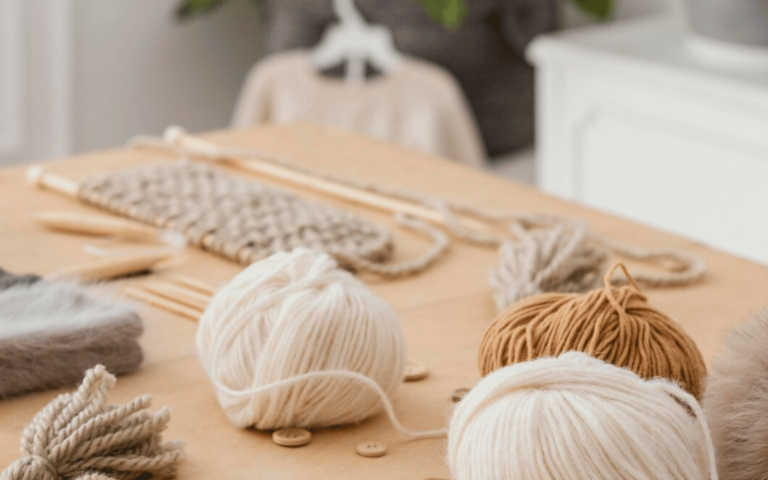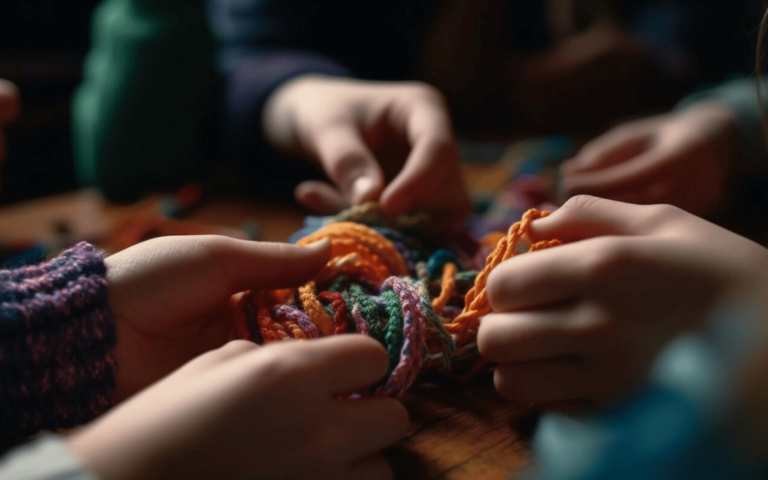Knitting with Cables: A Comprehensive Tutorial for Understanding This Popular Technique
Knitting is a craft beloved for its versatility and the sense of accomplishment it brings. Among the many knitting techniques, cable knitting stands out for its unique and intricate patterns. Cables are a series of stitches that cross over each other, creating the appearance of twisted ropes or braids in your fabric. The texture and depth they add to your knitting projects are simply mesmerizing. In this comprehensive tutorial, we will go for the world of cable knitting, from the basics to advanced techniques, enabling you to learn this popular and rewarding knitting skill.
Understanding Cable Knitting
Cable knitting is a technique that involves working stitches out of order to create raised, twisted motifs within your knitting. These motifs can vary from simple twists to more complex, intertwining designs. The result is a beautifully textured fabric that adds depth and visual interest to your projects. Cable knitting isn’t a recent innovation; it has a rich history in knitting traditions. Cable patterns were historically found in Aran sweaters, a style originating from the Aran Islands in Ireland. These patterns often symbolize different aspects of island life and were unique to each family. The technique has since evolved, and today, cable knitting is not limited to Aran sweaters. You can find cable patterns in a wide range of knitting projects, from scarves and hats to cardigans and blankets. The variety of cable patterns and their adaptability to different items make cable knitting a favorite among knitters of all levels. Understanding the roots and evolution of cable knitting will help you appreciate the rich tradition and artistry behind this technique.
Essential Materials and Tools
To embark on your cable knitting journey, you’ll need some essential materials and tools. Yarn selection is critical. Opt for a yarn that highlights the texture created by cable stitches. Worsted-weight yarns are a popular choice for cable knitting because they show off the twists and turns effectively. For beginners, light-colored yarns can be helpful as they make it easier to see your stitches. Your choice of needles is equally important. Circular needles are versatile and work well for cable projects, particularly if you’re knitting in the round. The right cable needle is a tool in cable knitting. It’s used to hold a few stitches out of the way while you knit others. You can find cable needles in various materials, such as metal, plastic, or bamboo, and in different shapes. Some cable needles are straight, while others are curved or U-shaped. The choice of cable needle is a matter of personal preference, and you may want to try a few Sorts to see which one feels most comfortable for you. The right tools will not only make your cable knitting experience more enjoyable but also ensure that your projects turn out beautifully.
Basic Cable Knitting Techniques
To start your cable knitting adventure, you’ll need to grasp the basics. Cable knitting primarily involves two fundamental techniques: cable front (C6F) and cable back (C6B). These are abbreviated forms used in patterns and indicate which way the cable needle should hold the stitches. For example, C6F means you move three stitches to a cable needle, hold them in front, knit the next three stitches from the left-hand needle, and then knit the three stitches from the cable needle. This creates a left-leaning cable. On the other hand, C6B means you hold the three stitches in the back, knit the next three from the left-hand needle, and then knit the stitches from the cable needle, resulting in a right-leaning cable. While these abbreviations might seem intimidating at first, they are relatively simple once you understand the process. You’ll be creating intricate cable patterns in no time, giving your knitting projects a professional and artistic touch.
Building Blocks: Cable Stitch Patterns
The heart of cable knitting lies in the stunning cable stitch patterns you can create. You can start with simple twists and crosses, creating a foundation for more complex designs. Some popular cable stitch patterns include the classic rope cable, which mimics a thick twisted rope, and the honeycomb cable, forming a beautiful, structured hexagonal pattern. As you progress, you can tackle more intricate designs like the Celtic cable, which draws inspiration from traditional Celtic knotwork, or the horseshoe cable, believed to bring good luck. Each of these stitch patterns has its unique charm and complexity. Understanding these cable patterns opens up a world of creativity. You can mix and match cable patterns to design unique knitting projects, from personalized scarves to intricate sweaters. Learning the intricacies of these patterns will not only hone your cable knitting skills but also spark your imagination, allowing you to craft beautiful and distinct pieces.
Troubleshooting and Tips
Like any knitting technique, cable knitting has its share of challenges. Dropped stitches are a common issue. When you notice a dropped stitch in a cable pattern, don’t panic. You can use a crochet hook or a cable needle to gently bring the dropped stitch back up and correct it. Another common challenge is accidentally twisting your cable in the wrong direction. This can be frustrating but is easily fixed by carefully unraveling the stitches that went awry and redoing the cable in the correct direction. To make your cable knitting experience smoother, it’s a good practice to use stitch markers. These can help you keep track of your cable sections and ensure that your pattern doesn’t go off course. Tension is another critical aspect of cable knitting. To achieve Finest results, strive to maintain even tension throughout your work. Keeping an even tension is when working on cable patterns, as irregular tension can distort the cables and affect the overall appearance of your project.
Advanced Cable Techniques
Once you’ve understood the basics of cable knitting, you can delve into more advanced techniques. These include traveling cables, where a cable pattern moves diagonally across your fabric, and lace cables, which combine the elegance of lace knitting with the texture of cables. These techniques open up new horizons for creativity and allow you to design intricate patterns for your projects. You can also delve into the world of reversible cables, which look stunning on both sides, making them ideal for scarves and blankets. Traveling cables create a dynamic and visually appealing effect as your cables move in a diagonal direction, intersecting with other cables or stitch patterns. Lace cables introduce delicate openwork into your cable patterns, resulting in a lovely combination of texture and airiness. The ability to combine these techniques opens up endless design possibilities for knitting projects, from delicate shawls to cozy cardigans. As you go into advanced cable techniques, you’ll find yourself pushing the boundaries of your creativity, making your knitting even more exciting and rewarding.
Cable Knitting in the Round
Cable knitting in the round is a popular choice for projects like hats, cowls, and mittens. The transition from flat to circular cable knitting can be seamless with the right guidance. Circular needles are ideal for this purpose, and you’ll learn how to adapt your cable patterns to a circular format. Creating stunning cable patterns in the round adds an extra layer of texture and dimension to your projects, making them stand out as unique and visually appealing. One of the advantages of circular cable knitting is that it eliminates the need for seams, resulting in a more polished and comfortable finish. In this section, you’ll discover the techniques for knitting cable patterns in the round, whether you’re working on a cozy cowl or a stylish beanie. With the right skills and understanding, you’ll be able to craft beautiful and seamless cable-knit items for yourself or as thoughtful gifts for others.
Garment and Home Décor Projects
One of the joys of learning cable knitting is the ability to create a wide range of projects. Whether you want to craft cozy sweaters and cardigans for yourself or design beautiful blankets and pillow covers to adorn your home, cable knitting offers endless possibilities. In this section, you’ll find inspiration and patterns to get you started on various cable knitting projects. Sweaters and cardigans are some of maximum popular garments that incorporate cable knitting. The texture and depth created by cable patterns add a touch of elegance and warmth to these pieces. You’ll find patterns for classic cable-knit cardigans, cabled pullovers, and textured vests. Beyond clothing, cable knitting is an excellent choice for home décor projects. You can create stunning cable-knit blankets, adding a cozy and inviting touch to your living space. Pillow covers with cable patterns also make for attractive accents, enhancing the comfort and style of your home.
Finishing and Blocking
Properly finishing your cable knitting projects is to achieving a polished and professional look. You’ll learn how to weave in ends neatly, seam pieces together seamlessly, and add buttons or zippers if needed. Additionally, blocking is an essential step to enhance the appearance and drape of your cable-knit garments. We’ll guide you through the blocking process and provide tips to ensure your cable-knit items look their best. Blocking involves wetting your finished item, shaping it to the desired dimensions, and allowing it to dry. This process helps even out the tension, enhance the stitch definition, and bring out the full beauty of your cable patterns. It’s a transformative step that elevates the quality of your knitting projects, ensuring they look as professional and well-finished as store-bought items. With the right finishing and blocking techniques, your cable-knit items will be ready to wear or display with pride.
Tips for Designing Your Cable Patterns
For those seeking a more creative and personalized approach, designing your cable patterns can be incredibly rewarding. We’ll discuss the basics of charting and writing cable patterns, allowing you to express your unique style and bring your design ideas to life. Whether you want to incorporate personal symbols or create a pattern that tells a story, this section will provide valuable insights into designing your cable patterns. Creating your cable patterns allows you to bring a unique touch to your knitting projects. You can design patterns that reflect your interests, heritage, or personal style. Developing your cable patterns is an advanced skill, but with practice and understanding, you’ll be able to craft truly one-of-a-kind items that showcase your creativity and individuality.
Celebrating the Art of Cable Knitting
In the final section of this comprehensive tutorial, we’ll reflect on the enduring appeal of cable knitting. The sense of accomplishment and self-expression it offers is something to celebrate. Cable knitting allows you to create beautiful, timeless pieces that showcase your skill and dedication. As you look into the art of cable knitting and embrace its challenges and rewards, you’ll find yourself captivated by this beloved knitting technique. It’s not just a craft; it’s a journey of creativity and self-expression. Knitting with cables is a remarkable and artistic way to bring your ideas to life through a traditional yet ever-evolving craft.
Significance of Cable Knitting
Knitting, as a craft, has roots that are both ancient and rich, weaving through the fabric of numerous societies across the globe. Among the many techniques that have emerged from this storied past, cable knitting holds a unique place, celebrated not just for its intricate beauty but also for its practical applications. The evolution of cable knitting can be traced back several centuries, with its origins often shrouded in the mists of Celtic and Gaelic traditions. Early examples were not just expressions of creativity but served as functional elements in the garments of fishermen and farmers, providing extra warmth and protection against the harsh climates of the northern seas and rugged landscapes.
Cable patterns, with their intricate twists and turns, are believed to carry meanings, with each design telling a story or bestowing a blessing. While the veracity of these attributions is the subject of folklore, the symbolism intertwined with cable knitting has undeniably contributed to its lasting appeal. As cable knitting techniques were passed down through generations, they became emblematic of cultural identity, particularly in regions known for their knitting traditions, such as the Aran Islands off the coast of Ireland. The iconic Aran sweaters, adorned with complex cable patterns, are perhaps the most recognized manifestation of this craft, often associated with familial clans and the depiction of fishermen’s ropes, the weaves of life, and the intertwining of community and nature.
Despite its ancient roots, cable knitting has adapted remarkably well to the changing times, illustrating the dynamic nature of textile arts. With the advent of industrialization and the subsequent evolution of knitting from a necessity to a hobby, cable knitting has seen a resurgence in popularity among modern crafters seeking to connect with traditional techniques. This resurgence is not merely a nod to nostalgia but a testament to the adaptability of cable knitting to contemporary fashion and design trends. Modern interpretations of cable knitting stretch beyond the conventional, incorporating vibrant colors, sustainable materials, and innovative designs that challenge the conventional boundaries of the craft.
The technique of cable knitting itself involves manipulating stitches to create patterns that appear to twist and cross over each other, creating a raised texture that adds depth and dimension to the fabric. This process, while initially daunting to beginners, offers a rewarding journey of skill mastery and artistic expression. The versatility of cable knitting allows for its application in a wide range of projects, from the traditional sweaters and scarves to more unexpected items like blankets, hats, and even intricate pieces of art. The transformation of simple yarn into complex patterns exemplifies the blend of technical skill and creative vision that defines the essence of knitting as a craft.
As cable knitting continues to evolve, it also serves as a bridge between the past and the present, connecting the modern knitter to a lineage of artisans who have shaped the craft over centuries. This connection is not merely historical but deeply personal, as each knitter brings their interpretation and innovation to the patterns they create. The global knitting community, facilitated by the internet and social media, has played a pivotal role in the diffusion of cable knitting techniques, fostering a shared culture of learning, inspiration, and collaboration. Through forums, online tutorials, and social media platforms, knitters around the world exchange tips, patterns, and stories, enriching the collective knowledge and ensuring the continuity of this beloved technique.
The historical evolution and cultural significance of cable knitting underscore its enduring appeal and its place within the broader tapestry of textile arts. From its utilitarian origins to its status as a symbol of cultural heritage and artistic expression, cable knitting embodies the confluence of tradition and innovation. As we continue to explore and celebrate the art of cable knitting, we not only pay homage to the generations of knitters who have preserved and enriched this technique but also contribute to its ongoing narrative, ensuring its place in the future of crafting and design.
Outcome
In the world of knitting, understanding cable knitting stands as a testament to your skills and creativity. This comprehensive tutorial has delved deep into the art of cable knitting, equipping you with the knowledge and techniques necessary to create stunning cable patterns with confidence. We began by understanding the history and significance of cable knitting, unraveling the roots of this art form and its evolution into a versatile and cherished technique. From there, we dived into the essential materials and tools needed for your cable knitting journey, ensuring that you have the right equipment to embark on your projects successfully.
Building a strong foundation in cable knitting involves grasping the basics, from fundamental cable techniques to an understanding of the cable stitch patterns that serve as the building blocks for intricate designs. We covered troubleshooting and tips to help you navigate common challenges, ensuring your cable knitting remains a pleasurable experience. For those who seek to push their boundaries, we examined advanced cable techniques, such as traveling cables and lace cables, which add an extra layer of artistry to your projects. We introduced you to the world of cable knitting in the round, allowing you to create seamless and visually appealing items like hats and cowls. The joy of cable knitting lies in its versatility. We offered project ideas, from cozy garments to stylish home decor items, letting your creativity flow and your knitting needles dance. Proper finishing and blocking ensure that your cable-knit projects are not just beautiful but also polished and professional. We walked you through the techniques needed to bring out Finest in your work, allowing you to enjoy the fruits of your labor for years to come.
For those who crave even more creativity, we analyzed the world of designing your cable patterns. By charting and writing your patterns, you have the strength to infuse your knitting projects with your unique style and individuality. Finally, we celebrated the art of cable knitting, acknowledging the sense of accomplishment and self-expression it brings. Cable knitting is not merely a craft; it’s a journey that allows you to create beautiful, timeless pieces that showcase your skill and dedication. As you go into the world of cable knitting, remember that practice is key. The more you knit, the more confident and skilled you will become. Embrace the challenges, savor the rewards, and celebrate the artistry of cable knitting. Whether you’re knitting for yourself, your loved ones, or simply for the joy of creation, cable knitting is a remarkable and artistic way to bring your ideas to life through a traditional yet ever-evolving craft.







